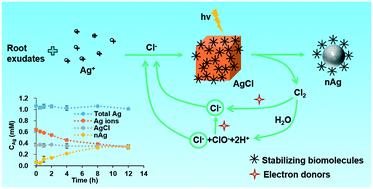当前位置:
X-MOL 学术
›
Environ. Sci.: Nano
›
论文详情
Our official English website, www.x-mol.net, welcomes your feedback! (Note: you will need to create a separate account there.)
New insight into naturally formed nanosilver particles: role of plant root exudates
Environmental Science: Nano ( IF 7.3 ) Pub Date : 2021-4-20 , DOI: 10.1039/d0en01188f Huiyuan Guo 1, 2, 3, 4, 5 , Feng Han 6, 7, 8, 9, 10 , Heping Shang 4, 5, 11, 12 , Sicheng Xiong 4, 5, 11, 12 , My Huynh 4, 5, 11, 12 , Lauren Thistle 4, 5, 11, 12 , Liting Meng 4, 5, 11, 12 , Lili He 4, 11, 12, 13 , Baoshan Xing 4, 5, 11, 12
Environmental Science: Nano ( IF 7.3 ) Pub Date : 2021-4-20 , DOI: 10.1039/d0en01188f Huiyuan Guo 1, 2, 3, 4, 5 , Feng Han 6, 7, 8, 9, 10 , Heping Shang 4, 5, 11, 12 , Sicheng Xiong 4, 5, 11, 12 , My Huynh 4, 5, 11, 12 , Lauren Thistle 4, 5, 11, 12 , Liting Meng 4, 5, 11, 12 , Lili He 4, 11, 12, 13 , Baoshan Xing 4, 5, 11, 12
Affiliation

|
Manufactured silver nanoparticles (nAg) have been extensively studied because of questions and concerns on their unique properties, behavior and associated impacts on environmental health and safety. In contrast, naturally formed nAg, as one long-existing source of nanoparticles, have been less noticed and investigated. In this study, we evaluated the ability of natural ligands in plant root zone – root exudates (RE) – in transforming silver ions (Ag+) to nAg and investigated the associated mechanism. We found that wheat RE had high reducing ability to convert Ag+ to nAg under light exposure. A further test on molecular weight (MW)-based RE fractions showed that the photo-induced reduction of Ag+ to nAg in pristine RE was mainly attributed to the 0–3 kDa fraction. Quantification of the silver species change over time suggested that Cl− played an important role in photoconversion of Ag+ to nAg through the formation and redox cycling of photoreactive AgCl. The accelerative function of AgCl as a photocatalyst was further demonstrated by the dramatically decreased generation of nAg in the dark. Potential electron donors for the photoreduction of Ag+ were identified to be reducing sugars and organic acids of low MW. Meanwhile, the stability of the formed particles was controlled by both low (0–3 kDa) and high (>3 kDa) MW molecules. This study provides new insight into the formation mechanism of metal nanoparticles mediated by RE, which may further our understanding of the biogeochemical cycling and toxicity of heavy metal ions in agricultural and environmental systems.
中文翻译:

对天然形成的纳米银颗粒的新见解:植物根系分泌物的作用
由于对银纳米颗粒(nAg)的独特性能,行为以及对环境健康和安全的相关影响,人们对此进行了广泛的研究,因此对人造银纳米颗粒(nAg)进行了广泛的研究。相比之下,作为一种长期存在的纳米颗粒来源,天然形成的nAg很少受到关注和研究。在这项研究中,我们评估了植物根部区域的天然配体-根系分泌物(RE)-将银离子(Ag +)转化为nAg的能力,并研究了相关的机制。我们发现,小麦RE在光照下具有很高的还原能力,可以将Ag +转化为nAg。对基于分子量(MW)的RE馏分的进一步测试表明,光诱导还原了Ag +原始RE中nAg的含量主要归因于0–3 kDa分数。银种变化随时间的定量表明,氯-发挥银的光转化具有重要作用+通过光敏氯化银的形成和氧化还原循环唠叨。在黑暗中,nAg的生成显着减少,进一步证明了AgCl作为光催化剂的促进功能。Ag +光还原的潜在电子给体被鉴定为低分子量的还原糖和有机酸。同时,形成的颗粒的稳定性受低(0–3 kDa)和高(> 3 kDa)MW分子的控制。这项研究为稀土介导的金属纳米颗粒的形成机理提供了新的见解,这可能使我们进一步了解生物地球化学循环以及重金属离子在农业和环境系统中的毒性。
更新日期:2021-04-27
中文翻译:

对天然形成的纳米银颗粒的新见解:植物根系分泌物的作用
由于对银纳米颗粒(nAg)的独特性能,行为以及对环境健康和安全的相关影响,人们对此进行了广泛的研究,因此对人造银纳米颗粒(nAg)进行了广泛的研究。相比之下,作为一种长期存在的纳米颗粒来源,天然形成的nAg很少受到关注和研究。在这项研究中,我们评估了植物根部区域的天然配体-根系分泌物(RE)-将银离子(Ag +)转化为nAg的能力,并研究了相关的机制。我们发现,小麦RE在光照下具有很高的还原能力,可以将Ag +转化为nAg。对基于分子量(MW)的RE馏分的进一步测试表明,光诱导还原了Ag +原始RE中nAg的含量主要归因于0–3 kDa分数。银种变化随时间的定量表明,氯-发挥银的光转化具有重要作用+通过光敏氯化银的形成和氧化还原循环唠叨。在黑暗中,nAg的生成显着减少,进一步证明了AgCl作为光催化剂的促进功能。Ag +光还原的潜在电子给体被鉴定为低分子量的还原糖和有机酸。同时,形成的颗粒的稳定性受低(0–3 kDa)和高(> 3 kDa)MW分子的控制。这项研究为稀土介导的金属纳米颗粒的形成机理提供了新的见解,这可能使我们进一步了解生物地球化学循环以及重金属离子在农业和环境系统中的毒性。



























 京公网安备 11010802027423号
京公网安备 11010802027423号